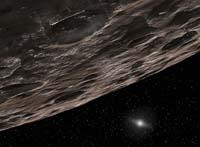Is density decisive?

Observations made with the Hawaii-ho Keck telescope reinforce the migration theory of gaseous giants.
According to theory, when the Milky Way was very young, the orbits of the gas giants were much closer to the Sun than now. Over time, due to gravitational forces, these planets (Jupiter, Saturn, Uranus and Neptune) moved away. It seems that this migration caused changes in the objects found in the Kuiper belt, among which are some that have become trapped in the orbit of the planets.
Thanks to the Keck telescope they have seen signs that confirm this theory. In fact, two asteroids in Jupiter's orbit, the pair Patroclus, appear to have a density similar to that of the comets. From there it follows that they emerged in the Kuiper belt, where objects abound with this density.
However, not all astronomers agree with the conclusion. In fact, Jupiter is five times farther from the Sun than the Earth, and there it is possible to create a couple like Patroclus. They say it is not necessary that it be created in Kuiper's belt to have that density.





